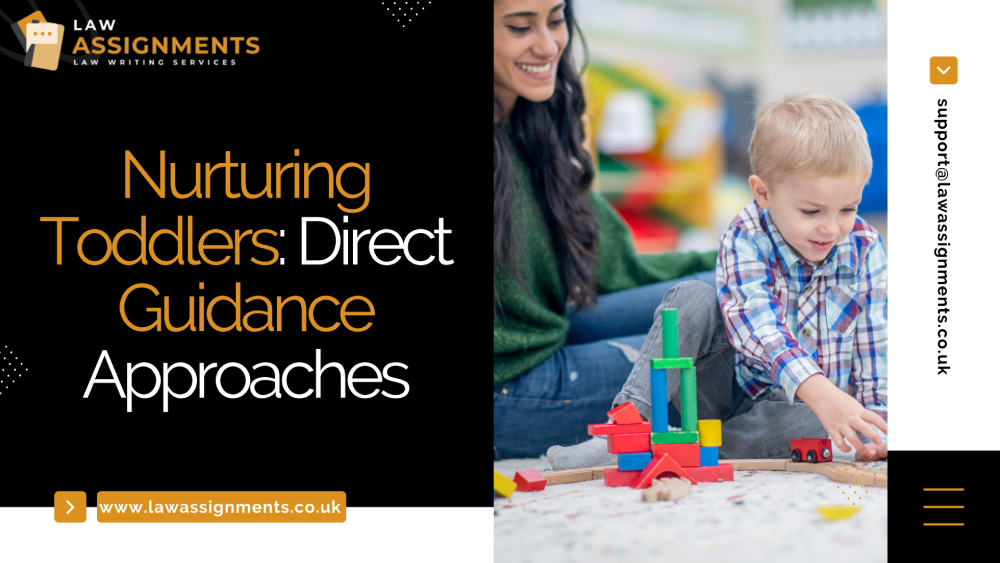Nurturing Toddlers: Direct Guidance Approaches

In this module, you will learn about guiding children directly. There will be a focus on guiding infants, toddlers and 3-through-8-year-olds. Real-life examples will be provided to aid student comprehension of each direct guidance strategy. Explore expert law assignment writing uk to learn more about this topic and complete your assignment successfully.
This assignment requires students to actively read (survey, question, read, recite, review) and synthesize all required weekly module learning opportunities (textbook, articles, videos and presentations) and will be submitted weekly (as assigned) before the beginning of each class meeting time.
The summary should consist of three sections:
Introduction: This should be an overall summary of the module learning opportunities (1-2 paragraphs).
Body: Three paragraphs, each with a major theme supported by several of the module learning opportunities. incorporate at least 3-5 major points that are related across all sources in the module learning opportunities. Each of these paragraphs should have a minimum of two different sources cited in each paragraph for a total of six sources for the entire assignment. Remember, The goal is to integrate information, Rather than provide an independent summary of each learning opportunity.
Conclusion: This paragraph wraps up and summarizes the major themes introduced in the body of the summary.
Make certain that every summary extends over a minimum of three pages and follows the writing style outlined by the american psychological association (apa) for both reference citations and composition. include the title page, running head, and reference page, but exclude them from the total page count. Adopt a persuasive writing style, steering clear of first-person and second-person pronouns. Instead, utilize third-person plural and articulate statements in the context of “ought” and “should.” Avoid expressions such as “i think” and “i believe.”
Limit direct quotes to no more than 10% of the paper. Summarize and paraphrase more than quoting and follow apa guidelines for formatting quotes. Failure to cite direct quotes appropriately constitutes plagiarism. Include page or paragraph numbers in citations for all direct quotes.
Attachment and human development opens in new window
Child development opens in new window
Developmental psychology opens in new window
The family journal opens in new window
Child development perspectives open in new window
Websites
Zero to three open in new window
Center for effective parenting opens in new window
Program for infant/toddler care opens in new window
Rie (resources for infant educarers) opens in new window
Brazelton touchpoints center opens in new window
National association for the education of young children opens in new window
Nontessori online opens in new window
Recommended readings
Gallahger, k., & mayer, k. (2008). Enhancing development and learning through teacher-child relationships. Young children, 63(6), 80–87.
Harris, k. i., pretti-frontczak, k., & brown, t. (2009). Peer-mediated intervention: An effective, inclusive strategy for all children. Young children, 64(2), 43–49.
Wien, c. a. (2004). from policy to participation: Overturning the rules and creating amiable classrooms. Young children, 59(1), 34–40.
Wohlwend, k. e. (2004/2005). Chasing friendship: Acceptance, rejection, and recess play. Childhood education, 81(2), 77–82.
Evans, b. (2002). you can’t come to my birthday party: Conflict resolution with young children. Ypsilanti, mi: high/scope press.
Swick, k. j. (2004). The dynamics of families who are homeless: Implications for early childhood educators. childhood education. 80(3) spring 2004. pp. 116– 120.
White, b. a., graham, m., bradford, s. k. (2005, march). Children of teen parents: challenges and hope. Zero to three. pp. 4–6.
Williams, t. (2005, may 21). A place for grandparents who are parents again. New york times, pp. b1, b6.